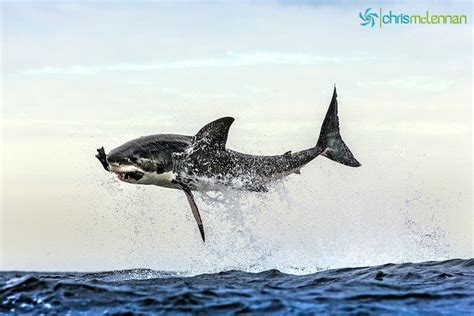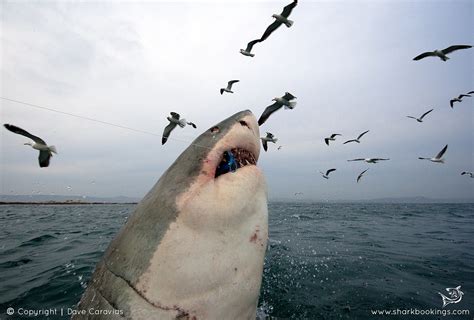The awe-inspiring phenomenon of great white breaching is a spectacle that has captivated the imagination of people around the world. This extraordinary behavior, where a great white shark launches itself out of the water, is a testament to the power, agility, and hunting prowess of these magnificent creatures. But what drives great whites to breach, and what can we learn from this fascinating behavior?
To understand great white breaching, it’s essential to delve into the world of these apex predators. Great whites are found in coastal and offshore waters in all major oceans, and they are known for their impressive size, with some individuals reaching lengths of up to 20 feet and weighing over 5,000 pounds. These sharks are built for speed and agility, with a streamlined body, a powerful tail, and a conical snout that allows them to detect the electromagnetic fields of their prey.
One of the primary reasons great whites breach is to hunt and kill their prey. In the coastal waters of South Africa, for example, great whites have been observed breaching to catch seals and other marine mammals. By launching themselves out of the water, great whites can surprise their prey, using the element of speed and stealth to their advantage. This hunting strategy is particularly effective in shallow waters, where the sharks can use the cover of the sea floor to ambush their unsuspecting prey.
Another reason great whites breach is to communicate and establish dominance. In the presence of other sharks, breaching can be a way for an individual to assert its dominance, warning other sharks to stay away. This behavior is often observed in areas with high shark activity, such as near seal colonies or in areas with abundant fish stocks. By breaching, a great white shark can signal its size, strength, and aggression, deterring potential competitors from entering its territory.
Great white breaching can also be a sign of curiosity and exploration. In some cases, sharks have been known to breach in the presence of boats or other underwater structures, possibly investigating the source of noise or vibrations. This behavior highlights the intelligence and adaptability of great whites, which are capable of navigating complex underwater environments and interacting with their surroundings in a highly nuanced way.
Great white breaching is a complex behavior that is not yet fully understood. However, research suggests that it is closely linked to the shark's brain structure and function. Studies have shown that great whites have a highly developed brain-to-body mass ratio, which enables them to process complex sensory information and make rapid decisions. This cognitive ability, combined with their powerful physiology, makes great whites one of the most formidable predators in the ocean.
Despite the many theories about great white breaching, there is still much to be learned about this fascinating behavior. Scientists continue to study great whites in their natural habitat, using advanced technologies such as underwater cameras, satellite tracking, and acoustic monitoring to gain insights into the lives of these incredible animals.
Comparative Analysis: Breaching Behavior in Other Shark Species

While great whites are the most well-known breeders, other shark species also exhibit breaching behavior. The mako shark, for example, is capable of breaching at speeds of up to 46 miles per hour, making it one of the fastest-swimming sharks in the ocean. The tiger shark, on the other hand, is known for its powerful breaching ability, which it uses to catch prey such as sea lions and dolphins.
| Shark Species | Breaching Speed | Prey |
|---|---|---|
| Great White | Up to 35 miles per hour | Seals, sea lions, fish |
| Mako Shark | Up to 46 miles per hour | Fish, squid, crustaceans |
| Tiger Shark | Up to 25 miles per hour | Sea lions, dolphins, fish |

Conservation Implications: Protecting Great Whites and Their Habitats

Great white breaching is not only an awe-inspiring spectacle but also an important indicator of the health of our oceans. As apex predators, great whites play a vital role in maintaining the balance of marine ecosystems, and their loss could have far-reaching consequences for the entire food chain. However, great whites are facing numerous threats, including overfishing, habitat destruction, and climate change.
To protect great whites and their habitats, it’s essential to implement conservation measures that address these threats. This includes establishing marine protected areas, enforcing fishing regulations, and promoting sustainable fishing practices. By taking action to protect great whites and their ecosystems, we can help preserve the beauty and diversity of our oceans for future generations.
What is the average speed of a great white shark breach?
+The average speed of a great white shark breach is around 25-30 miles per hour, although some breaches have been recorded at speeds of up to 35 miles per hour.
Why do great white sharks breach in the presence of boats?
+Great white sharks may breach in the presence of boats due to curiosity or to investigate the source of noise or vibrations. However, this behavior is not fully understood and requires further research.
How can we protect great white sharks and their habitats?
+To protect great white sharks and their habitats, we need to implement conservation measures such as establishing marine protected areas, enforcing fishing regulations, and promoting sustainable fishing practices. Additionally, reducing pollution, protecting coastal ecosystems, and supporting research and education initiatives can help ensure the long-term survival of great whites.
In conclusion, great white breaching is a complex and fascinating behavior that continues to captivate scientists and the general public alike. By studying this behavior, we can gain valuable insights into the biology and ecology of great whites, as well as the importance of conservation efforts to protect these incredible animals and their habitats. As we continue to learn more about great whites and their behavior, we are reminded of the awe-inspiring power and beauty of the natural world, and the importance of preserving it for future generations.



